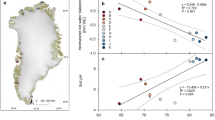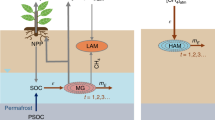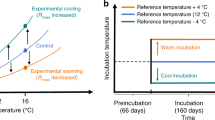Abstract
SOILS currently consume about 30–40 Tg methane per year1,2, which is comparable to the net annual increase in atmospheric methane concentration from 1980 to 19903. Most soils consume methane2,4–9, but the extent varies with soil water content, land use and ammonium inputs5,10–13. Ammonium concentrations in many soils have increased in recent years as a result of land-use changes and increases in ammonium concentration in precipitation14,15. Ammonium strongly inhibits soil methane consumption, but the mechanism is uncertain. Even if enhanced ammonium concentrations are subsequently reduced, inhibition can still persist for months to years12,13. Here we show, from field and laboratory experiments, that the extent of ammonium inhibition increases with increasing methane concentration. We propose that nitrite formation from methanotrophic ammonium oxidation accounts for much of the observed inhibition, and that the persistence of inhibition with reduced ammonium concentrations is due to the limited capacity of methanotrophs to grow or recover in present concentrations of atmospheric methane. We suggest that past increases in atmospheric methane concentration may have increased the inhibitory effect of ammonium, thereby decreasing soil methane uptake capacity, and that this mechanism could also provide a positive feedback on future atmospheric methane concentrations.
This is a preview of subscription content, access via your institution
Access options
Subscribe to this journal
Receive 51 print issues and online access
$199.00 per year
only $3.90 per issue
Buy this article
- Purchase on Springer Link
- Instant access to full article PDF
Prices may be subject to local taxes which are calculated during checkout
Similar content being viewed by others
References
Dörr, H., Katruff, L. & Levin, I. Chemosphere 26, 697–705 (1993).
Striegl, R. G., McConnaughey, T. A., Thorstenson, D. C. & Woodward, J. C. Nature 357, 145–147 (1992).
Steele, L. P., et al. Nature 358, 313–316 (1992).
Keller, M., Groeau, T. J., Wofsy, S. C., Kaplan, W. A. & McElroy, M. B. Geophys. Res. Lett. 10, 1156–1159 (1983).
Steudler, P. A., Bowden, R. D., Mellilo, J. M. & Aber, J. D. Nature 341, 314–316 (1989).
Born, M., Dörr, H. & Levin, I. Tellus 42B, 2–8 (1990).
Whalen, S. C. & Reeburgh, W. S. Nature 346, 160–162 (1990).
Adamsen, A. P. S. & King, G. M. Appl. envir. Microbiol. 59, 485–490 (1992).
Crill, P. M. Globl. Biogeochem. Cycles. 4, 319–334 (1991).
Whalen, S. C., Reeburgh, W. S. & Sandbeck, K. A. Appl. envir. Microbiol. 56, 3405–3411 (1990).
Keller, M., Mitre, M. E. & Stallard, R. F. Globl. Biogeochem. Cycles 4, 21–27 (1990).
Mosier, A., Schimel, D., Valentine, D., Bronson, K. & Parton, W. Nature 350, 330–332 (1991).
Nesbit, S. P. & Breitenbeck, G. A. Agric. Ecosys. Envir. 41, 39–54 (1992).
Nihlgård, B. Ambio 14, 2–8 (1985).
Willey, J. D. & Kiefer, R. H. J. Elisha Mitchell Sci. Soc. 109, 1–19 (1993).
Söderström, B., Bååth, E., & Lundgren, B. Can. J. Microbiol. 29, 1500–1506 (1983).
Keller, M., Veldkamp, E., Weitz, A. M. & Reiners, W. A. Nature 365, 244–246 (1993).
Bédard, C. & Knowles, R. Microbiol. Rev. 53, 68–84 (1989).
Hubley, J. H., Thomson, A. W. & Wilkinson, J. F. Arch. Mikrobiol. 95, 365–368 (1975).
O'Neill, J. G. & Wilkinson, J. F. J. gen. Microbiol. 100, 407–412 (1977).
Dalton, H. Arch. Mikrobiol. 114, 273–279 (1977).
Yoshinari, T. Can. J. Microbiol. 31, 139–144 (1985).
Jollie, D. R. & Lipscomb, J. D. J. biol. Chem. 266, 21853–21863 (1991).
Bender, M. & Conrad, R. FEMS Microbiol. Ecol. 101, 261–270 (1992).
Koschorreck, M. & Conrad, R. Globl Biogeochem. Cycles 7, 109–121 (1993).
Koch, A. L. Adv. microb. Ecol. 11, 37–70 (1990).
Georgii, H. W., Rerseke, C. & Rohbock, E. Atmos. Envir. 18, 581–589 (1984).
King, G. M. & Adamsen, A. P. S. Appl. envir. Microbiol. 58, 2758–2763 (1992).
Author information
Authors and Affiliations
Rights and permissions
About this article
Cite this article
King, G., Schnell, S. Effect of increasing atmospheric methane concentration on ammonium inhibition of soil methane consumption. Nature 370, 282–284 (1994). https://doi.org/10.1038/370282a0
Received:
Accepted:
Issue Date:
DOI: https://doi.org/10.1038/370282a0
This article is cited by
-
Biocrusts Modulate Responses of Nitrous Oxide and Methane Soil Fluxes to Simulated Climate Change in a Mediterranean Dryland
Ecosystems (2020)
-
Reduced mineral fertilization coupled with straw return in field mesocosm vegetable cultivation helps to coordinate greenhouse gas emissions and vegetable production
Journal of Soils and Sediments (2020)
-
Impacts of precipitation, warming and nitrogen deposition on methane uptake in a temperate desert
Biogeochemistry (2019)
-
A stable CH4 sink responding to extreme precipitation events in a fenced semiarid steppe
Journal of Soils and Sediments (2017)
-
A five-year study of the impact of nitrogen addition on methane uptake in alpine grassland
Scientific Reports (2016)
Comments
By submitting a comment you agree to abide by our Terms and Community Guidelines. If you find something abusive or that does not comply with our terms or guidelines please flag it as inappropriate.



